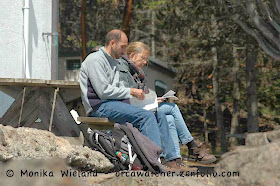DEC. 31 NOTE: For the second year in a row, blogging the review a day early got me in trouble, as there's still plenty of birding to be done on the last day of the year! This year, Dave tied me on the waning days, and despite my efforts, I couldn't regain the lead on December 31st. I did, however, add one more species - the eared grebe - to my county ear list.
There's one day left in 2013, which means one more day to add bird species to my year list. I've stalled out at 192, well short of my goal of 200 species,but still a single species ahead of exactly tied with my competitor Dave in England, who added the tying species on December 31st!. My dad, with his trip to eastern Canada, will finish well ahead at 219. Here's how the numbers break down this year:
There's one day left in 2013, which means one more day to add bird species to my year list. I've stalled out at 192, well short of my goal of 200 species,
|
|
2010
|
2011
|
2012
|
2013
|
|
Total # Bird
Species
|
233
|
203
|
222
|
192
|
|
Dave's Total
|
237
|
206
|
275/205*
|
|
|
Dad's Total
|
|
230
|
204
|
|
|
# States/
Provinces
|
6
|
4
|
5
|
4
|
|
# Life Birds
|
23
|
3
|
6
|
3
|
|
# SJ County
Species
|
133?
|
157
|
145
|
|
|
# Species by
Month
|
|
|
|
|
|
January
|
87
|
114
|
105
|
110
|
|
February
|
19
|
13
|
52
|
6
|
|
March
|
25
|
12
|
3
|
14
|
|
April
|
21
|
25
|
12
|
20
|
|
May
|
37
|
17
|
24
|
10
|
|
June
|
24
|
2
|
14
|
5
|
|
July
|
1
|
4
|
0
|
1
|
|
August
|
2
|
4
|
3
|
2
|
|
September
|
3
|
5
|
0
|
1
|
|
October
|
2
|
1
|
6
|
0
|
|
November
|
4
|
4
|
0
|
22
|
|
December
|
8
|
2
|
3
|
0
|
Last year the world traveler Dave was nice and granted me the win compared to his Europe total, but if I can hang on one more day this really feels like the first time I've beat him! (Nope, it's a tie!) I find it interesting how close we've been every year, and the fact that we're both in the low 190s this year after being above 200 in all the previous years.
The monthly numbers are interesting, but to make a comparison you also have to take into account when I've traveled outside of the northwest. Last year, it was a California trip in February. This year, it was a California trip in November!
The birding highlight of 2013 was undoubtedly my trip to California, which is also where I added my three life birds of the year, finally pushing my North American life list to over 350 species. My favorite hour of birding happened at Malibu Lagoon State Beach, where the year birds came fast and furious and the species diversity - so different form what I see in Washington - was really apparent.
So, what are the plans for 2014? I'm keeping my goal at 200 species, and hope to make it as well as add a few life birds on a trip south in February. It will likely be a slower start to the year list as for the first time I'll be starting it on San Juan Island instead of in Portland, where there's a better chance for a wider variety of species. I like to try and reach 100 species before the end of January, but I think that will be a tough one this year, even with a trip or two off island! I'll still give it a shot, so we shall see!







































































